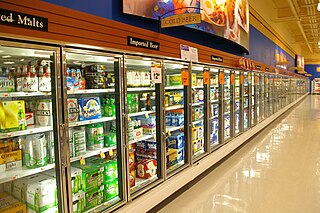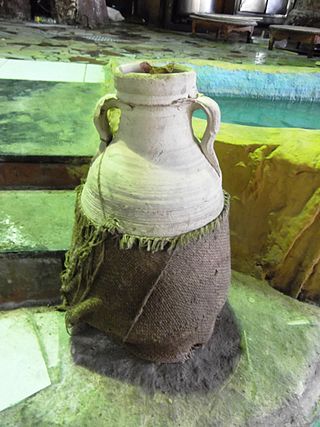An autonomous building is a building designed to be operated independently from infrastructural support services such as the electric power grid, gas grid, municipal water systems, sewage treatment systems, storm drains, communication services, and in some cases, public roads.

Refrigeration is any of various types of cooling of a space, substance, or system to lower and/or maintain its temperature below the ambient one. Refrigeration is an artificial, or human-made, cooling method.
The coefficient of performance or COP of a heat pump, refrigerator or air conditioning system is a ratio of useful heating or cooling provided to work (energy) required. Higher COPs equate to higher efficiency, lower energy (power) consumption and thus lower operating costs. The COP is used in thermodynamics.

An evaporative cooler is a device that cools air through the evaporation of water. Evaporative cooling differs from other air conditioning systems, which use vapor-compression or absorption refrigeration cycles. Evaporative cooling exploits the fact that water will absorb a relatively large amount of heat in order to evaporate. The temperature of dry air can be dropped significantly through the phase transition of liquid water to water vapor (evaporation). This can cool air using much less energy than refrigeration. In extremely dry climates, evaporative cooling of air has the added benefit of conditioning the air with more moisture for the comfort of building occupants.

A refrigerator, colloquially fridge, is a commercial and home appliance consisting of a thermally insulated compartment and a heat pump that transfers heat from its inside to its external environment so that its inside is cooled to a temperature below the room temperature. Refrigeration is an essential food storage technique around the world. The lower temperature lowers the reproduction rate of bacteria, so the refrigerator reduces the rate of spoilage. A refrigerator maintains a temperature a few degrees above the freezing point of water. The optimal temperature range for perishable food storage is 3 to 5 °C. A similar device that maintains a temperature below the freezing point of water is called a freezer. The refrigerator replaced the icebox, which had been a common household appliance for almost a century and a half. The United States Food and Drug Administration recommends that the refrigerator be kept at or below 4 °C (40 °F) and that the freezer be regulated at −18 °C (0 °F).

A cooler, portable ice chest, ice box, cool box, chilly bin, or esky (Australia) is an insulated box used to keep food or drink cool.

Cold chain is defined as the series of actions and equipment applied to maintain a product within a specified low-temperature range from harvest/production to consumption. An unbroken cold chain is an uninterrupted sequence of refrigerated production, storage and distribution activities, along with associated equipment and logistics, which maintain a desired low-temperature interval to keep the safety and quality of perishable or sensitive products, such as foods and medicines. In other words, the term denotes a low temperature-controlled supply chain network used to ensure and extend the shelf life of products, e.g. fresh agricultural produce, seafood, frozen food, photographic film, chemicals, and pharmaceutical products. Such products, during transport and end-use when in transient storage, are sometimes called cool cargo. Unlike other goods or merchandise, cold chain goods are perishable and always en-route towards end use or destination, even when held temporarily in cold stores and hence commonly referred to as "cargo" during its entire logistics cycle. Adequate cold storage, in particular, can be crucial to prevent quantitative and qualitative food losses.

An icemaker, ice generator, or ice machine may refer to either a consumer device for making ice, found inside a home freezer; a stand-alone appliance for making ice, or an industrial machine for making ice on a large scale. The term "ice machine" usually refers to the stand-alone appliance.

Icyball is a name given to two early refrigerators, one made by Australian Sir Edward Hallstrom in 1923, and the other design patented by David Forbes Keith of Toronto, and manufactured by American Powel Crosley Jr., who bought the rights to the device. Both devices are unusual in design in that they did not require the use of electricity for cooling. They can run for a day on a cup of kerosene, allowing rural users lacking electricity the benefits of refrigeration.

An absorption refrigerator is a refrigerator that uses a heat source to provide the energy needed to drive the cooling process. Solar energy, burning a fossil fuel, waste heat from factories, and district heating systems are examples of convenient heat sources that can be used. An absorption refrigerator uses two coolants: the first coolant performs evaporative cooling and then is absorbed into the second coolant; heat is needed to reset the two coolants to their initial states. Absorption refrigerators are commonly used in recreational vehicles (RVs), campers, and caravans because the heat required to power them can be provided by a propane fuel burner, by a low-voltage DC electric heater or by a mains-powered electric heater. Absorption refrigerators can also be used to air-condition buildings using the waste heat from a gas turbine or water heater in the building. Using waste heat from a gas turbine makes the turbine very efficient because it first produces electricity, then hot water, and finally, air-conditioning—trigeneration.
Solar air conditioning, or "solar-powered air conditioning", refers to any air conditioning (cooling) system that uses solar power.

An air source heat pump (ASHP) is a heat pump that can absorb heat from air outside a building and release it inside; it uses the same vapor-compression refrigeration process and much the same equipment as an air conditioner, but in the opposite direction. ASHPs are the most common type of heat pump and, usually being smaller, tend to be used to heat individual houses or flats rather than blocks, districts or industrial processes.

Thermodynamic heat pump cycles or refrigeration cycles are the conceptual and mathematical models for heat pump, air conditioning and refrigeration systems. A heat pump is a mechanical system that allows for the transmission of heat from one location at a lower temperature to another location at a higher temperature. Thus a heat pump may be thought of as a "heater" if the objective is to warm the heat sink, or a "refrigerator" or “cooler” if the objective is to cool the heat source. In either case, the operating principles are similar. Heat is moved from a cold place to a warm place.
Vaccine refrigerators are designed to store vaccines and other medical products at a stable temperature to ensure they do not degrade. In developing countries with a sunny climate, solar-powered vaccine refrigerators are common.

Ice storage air conditioning is the process of using ice for thermal energy storage. The process can reduce energy used for cooling during times of peak electrical demand. Alternative power sources such as solar can also use the technology to store energy for later use. This is practical because of water's large heat of fusion: one metric ton of water can store 334 megajoules (MJ) of energy, equivalent to 93 kWh.
The following outline is provided as an overview of and topical guide to solar energy:
Sure Chill Technology is a cooling technology that is currently being used in medical refrigerators, but is thought to have wider potential in the future for domestic refrigerators and beverage coolers. According to BBC, the refrigerator's temperature 'can stay at 4°C for more than 10 days without power, and is used mainly in Africa' to store vaccines and other medical supplies. It can be powered by electricity or solar, and uses the physics of water to store energy, thus not relying on batteries.

An ultra low temperature (ULT) freezer is a refrigerator that stores contents at −40 to −86 °C. An ultra low temperature freezer is commonly referred to as a "minus 80 freezer" or a "negative 80 freezer", referring to the most common temperature standard. ULT freezers come in upright and chest freezer formats.
Many vaccines require refrigeration to remain active, and the lack of infrastructure to maintain the cool chain to reliably bring vaccines into more remote areas of developing countries poses a serious challenge to national immunization programs. Portable vaccine cooler units have been proposed by several technologists. The WHO Performance, Quality and Safety (PQS) programme is a driver of the technology.

Vaccine storage relates to the proper vaccine storage and handling practices from their manufacture to the administration in people. The general standard is the 2–8 °C cold chain for vaccine storage and transportation. This is used for all current US Food and Drug Administration (FDA)-licensed human vaccines and in low and middle-income countries. Exceptions include some vaccines for smallpox, chickenpox, shingles and one of the measles, mumps, and rubella II vaccines, which are transported between −25 °C and −15 °C. Some vaccines, such as the COVID-19 vaccine, require a cooler temperature between −80 °C and −60 °C for storage.












